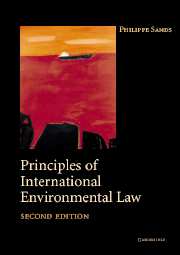Book contents
- Frontmatter
- Contents
- Foreword
- Preface and acknowledgments to the first edition
- Preface and acknowledgments to the second edition
- Table of cases
- Table of treaties and other international instruments
- List of abbreviations
- PART I The legal and institutional framework
- 1 The environment and international society: issues, concepts and definitions
- 2 History
- 3 Governance: states, international organisations and non-state actors
- 4 International law-making and regulation
- 5 Compliance: implementation, enforcement, dispute settlement
- PART II Principles and rules establishing standards
- PART III Techniques for implementing international principles and rules
- Index
1 - The environment and international society: issues, concepts and definitions
- Frontmatter
- Contents
- Foreword
- Preface and acknowledgments to the first edition
- Preface and acknowledgments to the second edition
- Table of cases
- Table of treaties and other international instruments
- List of abbreviations
- PART I The legal and institutional framework
- 1 The environment and international society: issues, concepts and definitions
- 2 History
- 3 Governance: states, international organisations and non-state actors
- 4 International law-making and regulation
- 5 Compliance: implementation, enforcement, dispute settlement
- PART II Principles and rules establishing standards
- PART III Techniques for implementing international principles and rules
- Index
Summary
Given that the land – and the sea – and the air-spaces of planet Earth are shared, and are not naturally distributed among the states of the world, and given that world transforming activities, especially economic activities, can have effects directly or cumulatively, on large parts of the world environment, how can international law reconcile the inherent and fundamental interdependence of the world environment? How could legal control of activities adversely affecting the world environment be instituted, given that such activities may be fundamental to the economies of particular states?
The environmental challenge
It is now widely recognised that the planet faces a diverse and growing range of environmental challenges which can only be addressed through international co-operation. Acid rain, ozone depletion, climate change, loss of biodiversity, toxic and hazardous products and wastes, pollution of rivers and depletion of freshwater resources are some of the issues which international law is being called upon to address. Since the mid-1980s, the early international legal developments which addressed aspects of the conservation of natural resources have crystallised into an important and growing part of public international law. The conditions which have contributed to the emergence of international environmental law are easily identified: environmental issues are accompanied by a recognition that ecological interdependence does not respect national boundaries and that issues previously considered to be matters of domestic concern have international implications.
- Type
- Chapter
- Information
- Principles of International Environmental Law , pp. 3 - 24Publisher: Cambridge University PressPrint publication year: 2003



